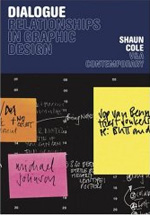


Sharing a topic of many of my recent, focused discussions (yes, offline discussions), it was a pleasant surprise to happen upon Dialogue. The premise, as the subtitle reveals, is covering the varying relationships that make up the interactions of contemporary design practice. The back cover teases with a promise of “in-depth analysis of key projects.”
 What’s between the covers is worth consideration, yet this deep analysis is absent. The introduction extends for 20 pages, while the case studies fill but 3 or 4 each. Maybe this is because of the quote-per-paragraph approach in the intro that left me feeling like I was a tennis ball on the court of design-stars: Sagmeister, Heller, Lupton, Carson?, etc, etc… Or maybe this disproportion is because the overview is where Cole is most comfortable. That’s what Dialogue really reads like: an overview, a survey.
What’s between the covers is worth consideration, yet this deep analysis is absent. The introduction extends for 20 pages, while the case studies fill but 3 or 4 each. Maybe this is because of the quote-per-paragraph approach in the intro that left me feeling like I was a tennis ball on the court of design-stars: Sagmeister, Heller, Lupton, Carson?, etc, etc… Or maybe this disproportion is because the overview is where Cole is most comfortable. That’s what Dialogue really reads like: an overview, a survey.
The plates are sizable for a book of this size (6” x 8” or so). The majority of the projects are European and of those most are British. Save Stefan Sagmeister’s Trying To Look Good Limits My Life, the selections are refreshing and new to a pair of American eyes.
If anything, Dialogue has a fair breadth: it covers a variety of designer situations from large communication conglomerates to freelancers. It does give a visually stimulating survey of the variety of working relationships in design. If Cole’s intentions were to provide a survey, however that may belie what was summaraized as in-depth, the survey could be compelling to those new to design. If it's not assigned reading in a design program somewhere, it probably should be.
For a hungry reader though, eager for a revealing text—a deeper analysis of the social mechanics of designing and how they affect the designed outcome—the book discloses no deeper than the norm. It’s been stated about client X and Cole tells us about client Y. What’s missing is the insight into why this client’s case study is of importance and was selected for inclusion over countless others. Nonetheless, I did enjoy reading it.
In short, designers work with other people. Those other people include bosses, clients, other designers, photographers, illustrators, vendors, competitors, spouses… It’s the friend of a friend of a benefactor of a former employer that’s most curious and most compelling. For this understanding of design relationships, the dialogue must continue.
![]()























